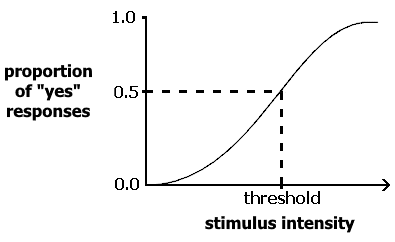
1. What are three classical psychophysical methods for measuring absolute thresholds?
2. What is the JND and how is it measured?
3. What are the differences between Weber’s law, Fechner’s law, and Stevens’s power law?
4. What evidence is there for Stevens’s law?
5. What is the main problem with classical psychophysics?
6. What is the theory of signal detection (TSD)?
7. How is an ROC curve constructed?
8. How are the response criterion (β) and sensitivity (d' ) independent?
9. What are the effects of subliminal stimuli?
10. How can brain activity be measured?
- study of the relationship between ________ quantities and the __________ of them
- can be used to understand detection, discrimination, and scaling of physical stimuli
________ threshold: minimal limit of a sense modality
• also called _____
• point at which physical stimulation enters into consciousness (threshold theory)
• present a stimulus to the observer and ask whether they can detect it
• minimum stimulus energy (or chemicals) required to be detected __% of the time
Methods of measurement:
• Method of ________ Stimuli: stimulus intensity chosen at random from a predetermined (“constant”) set on each trial (observation)
1. select intensity range: 0 to 100 lumens
2. determine set of values: 8, 97, 42, 8, 67, 4, 35, 51,...
3. observer says “yes” when stimulus perceived
4. record observations
5. plot results:

(at the threshold, the probabilities of saying “yes” and “no” are equal)
Pros & Cons:
![]() gives ____ estimate of threshold
gives ____ estimate of threshold
![]() time-consuming (must know proper range)
time-consuming (must know proper range)
![]() cannot measure threshold changes over ____ (e.g., in dark adaptation)
cannot measure threshold changes over ____ (e.g., in dark adaptation)
• Method of ______: change stimulus intensity monotonically
- increase stimulus intensity until it is perceived (ascending series) or reduce stimulus intensity until it is not perceived (descending series)
Pros & Cons:
![]() can track threshold changes over time
can track threshold changes over time
![]() induces errors of ___________
induces errors of ___________
![]() induces errors of ____________
induces errors of ____________
- ________ Testing variant: stimulus intensity changed over a continuous series
▸ e.g., staricase method: changes intensity from ascending to descending when “yes” encountered; vice-versa for “no”
▸ the point at which perception changes is called the turnaround
▸ choose different starting point for each series from trial to trial
▸ threshold may vary between trials: take the mean of the turnarounds
• Method of __________: observer directly controls stimulus values until threshold reached
Pros & Cons:
![]() fast
fast
![]() least ________ method
least ________ method
Difference threshold: minimum difference needed to discriminate between two stimuli, 50% of the time
• judgment made between standard and __________ stimuli (both are well above absolute threshold)
• a.k.a. “just __________ difference,” or JND
e.g., present 100 g standard vs. multiple comparison stimuli; ask whether there is a difference
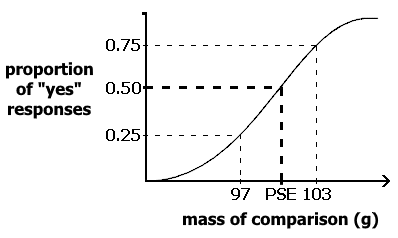
• 0.75 → upper difference threshold
• 0.25 → lower difference threshold
• difference threshold = (upper - lower) ÷ 2
• 0.50 → Point of __________ Equality (PSE): stimulus that is apparently most like the standard
(PSE may differ from standard stimulus)
Weber’s Law (1834):
Is the difference threshold the same for all standard stimuli, or does it vary somehow?
k = constant (“Weber fraction”) S = standard stimulus intensity |
e.g., for a 100 g weight, JND = 2 g (difference = 2%)
for a 1,000 g weight, JND = 20 g (difference = 2%)
Weber fraction = 2/100 = 0.02
Problem: “law” does not extend to extremes
![]() cannot be applied to stimuli close to ________ threshold
cannot be applied to stimuli close to ________ threshold
![]() also breaks down at higher stimulus intensities
also breaks down at higher stimulus intensities
What is the subjective magnitude of a stimulus?
e.g., are two 60 W lights _____ as bright as one 60 W light?
________ scaling: magnitude derived from multiple difference judgments
Fechner’s Law (1860): derived a scale based on two assumptions:
• Weber’s Law is _____
• basic perceptual unit is the ___
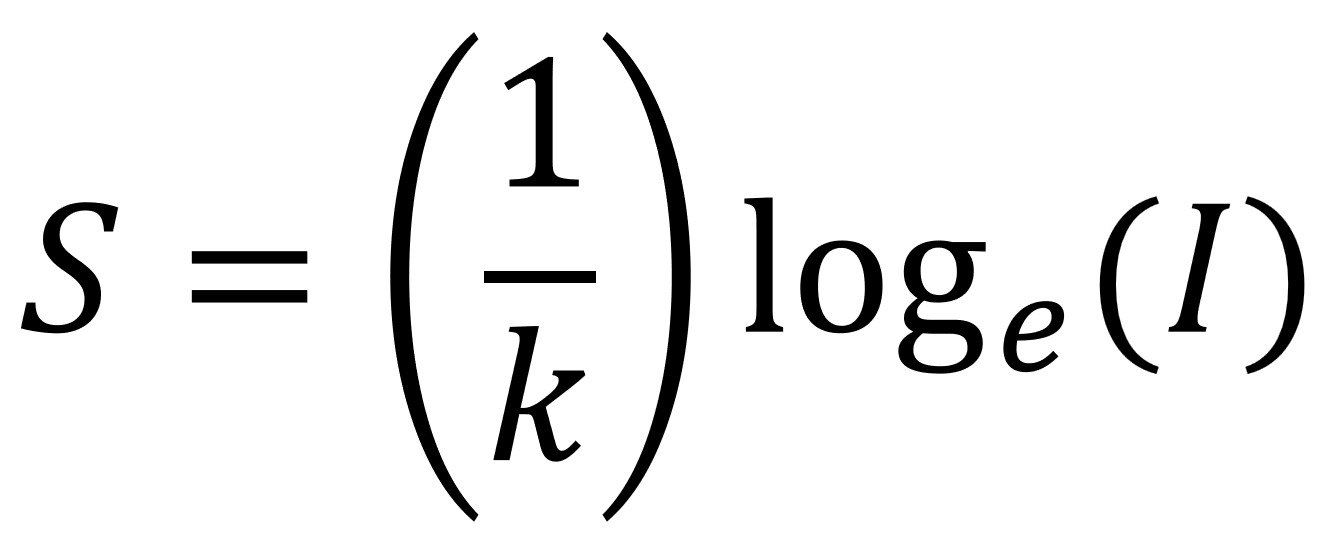 |
k = Weber fraction) I = stimulus intensity S = sensory experience |
e.g., what if intensity is doubled? Let k = 1
if I = 100, S = ____
if I = 200, S = ____
- doubling intensity does ___ make stimulus seem twice as big
e.g., a light 20 JNDs above threshold is twice as bright as a light 10 JNDs above threshold
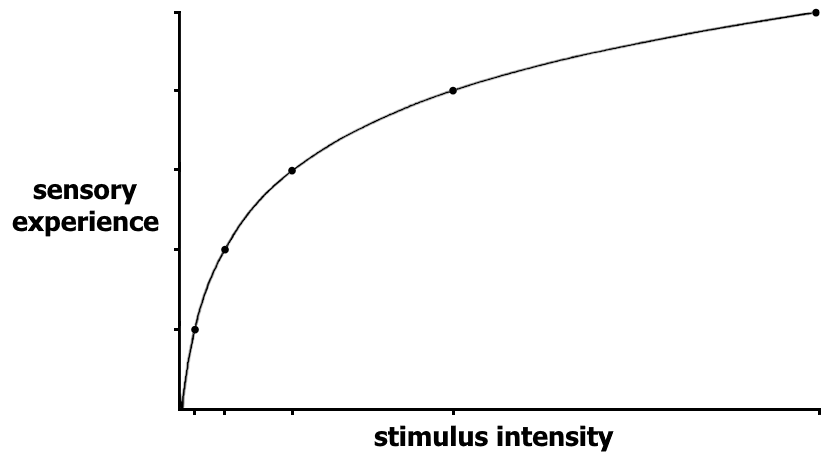
Problems:
![]() Weber’s Law breaks down at extremes
Weber’s Law breaks down at extremes
![]() research showed Fechner’s formulation was insufficient
research showed Fechner’s formulation was insufficient
______ scaling: observers assign values to stimulus intensities
_________ estimation:
1. observer presented with a reference stimulus (modulus); and a certain value (say, 10)
2. other stimuli are presented; observer assigns values to them (if half as bright, give it a 5; if twice as bright, 20, etc.)
• values of stimulus magnitude provided directly by observer
• results conflicted with Fechner’s Law; instead, a “_____ law” held:
Stevens’s Law (1957):
P = K S n |
P = perceived magnitude |
K = constant |
S = stimulus intensity | n = exponent |
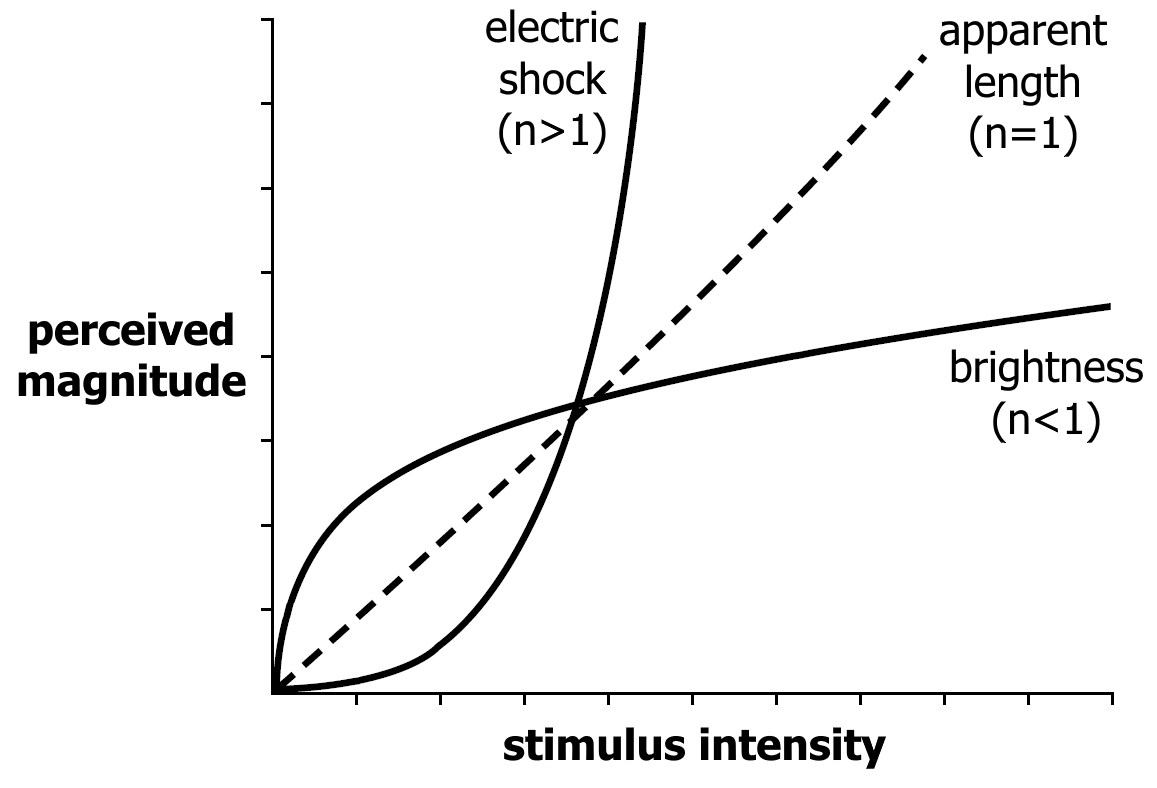
Exponent expresses nature of the relation:
n > 1: response _________
e.g., doubling voltage more than doubles sensation of electric shock
n = 1: linear ________: magnitude of response matches changes in physical quantity
e.g., estimates of line length, distance
n < 1: response ___________
e.g., doubling intensity of light produces only a small change in perceived brightness
Criticism: the lines describing Stevens’s Law all look very different:
Solution: plot a log-log graph:

- now the lines look similar
Criticism: Why does the system operate this way?
Answer: evolution
• pain very quickly becomes very ________
• estimating distances is very ________
• allows us to handle a _____ range of light intensities, and not be blinded either in a dim room or by sunlight
Criticism: magnitude estimation may tell us how people “use _______,” instead of how they judge stimuli
Problem: How to estimate magnitude without using verbal reports of numbers?
Solution: cross-________ matching: one sense used to provide a measure of intensity in another sense
• typically uses a hand dynamometer
• grip squeezed to indicate magnitude of stimulus
• ___________ (sense of movement of the parts of the body) used to estimate quantity in other modality
• results match magnitude estimation
(Tanner & Swets, 1954)
Problem: observer says “yes” a lot
- response ____ confounds attempts to measure sensitivity
Solution: _____ trials: no stimulus presented in half the trials
- help determine whether observer has a tendency to respond “yes” (or “no”) more frequently
Probability matrix:
Observer’s response: |
||
Stimulus: |
"yes" |
"no" |
present |
___ |
____ |
absent |
false _____ |
correct _________ |
Change probabilities by altering payoffs for each condition:
Make observer H.S. say “yes” more:
hit = +$10 |
miss = -$1 |
false alarm = -$1 |
correct rejection = +$1 |
Result: ____ hits and false alarms
Make observer H.S. say “no” a lot:
hit = +$1 |
miss = -$1 |
false alarm = -$1 |
correct rejection = +$10 |
Result: _____ hits and false alarms
Plot the data: ________ Operating Characteristic (ROC) curve
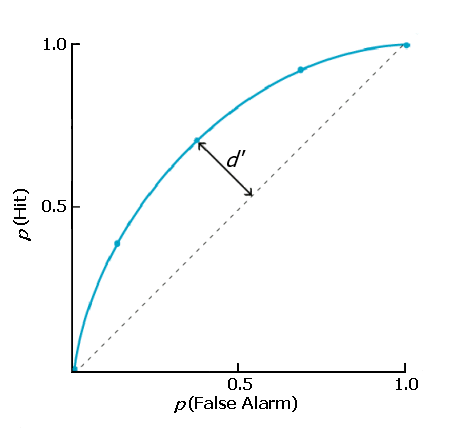
• each point on this curve represents a different payoff
• note: stimulus intensity has remained constant
• “bowing” of curve affected by:
- observer’s ___________
- _________ of stimulus
Why do people respond when there is no stimulus present?
• they are just really ____
• background “_____” exists in the sensory system
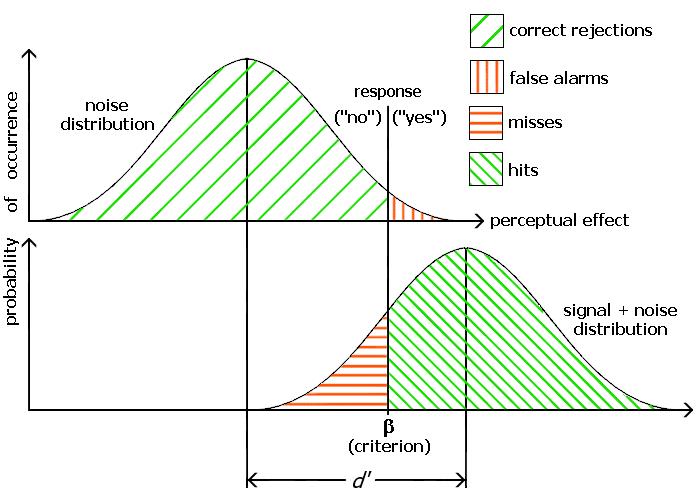
sensitivity (or discriminability, d':
• is the distance between the means of the noise and signal + noise distributions
• is ___________ of response criterion (β)
• the concept of threshold is not used in TSD
TSD and discriminating between stimuli:
• measured as discriminability (d' ) between two signal + noise distributions (S1+N vs. S2+N)
• both must be detectable
• a stimulus that is below threshold may be consciously detected up to __% of the time
• however, a subliminal stimulus is below threshold, and does not enter awareness
• Can we (unconsciously) sense subliminal stimuli?
• Will this information affect us without our awareness?
Evidence?
• 1957: movie audiences in New Jersey reportedly induced to buy snacks by subliminal messages (“EAT POPCORN”)
• 1980s: backward messages on records purportedly prompted suicides
• today: “sex” on crackers; nudes on ice cubes in liquor ads; naughty words/sayings in Disney cartoons
Murphy & Zajonc (1993): Can we process information without awareness?
- _______ study: investigates how exposure to a stimulus influences processing of subsequent stimuli
- priming stimuli:
• positive affective (happy face photo)
• negative affective (scowling face photo)
• irrelevant (geometric shape)
• no prime
- each prime was paired with a random Chinese character, presented on screen for 2 seconds
- observers rated their liking of Chinese characters out of 5
- two priming presentations: subliminal (4 ms) or suprathreshold (1,000 ms)
- results:
Ratings of character: |
subliminal |
suprathreshold |
positive prime |
3.46 |
3.02 |
negative prime |
2.70 |
3.28 |
irrelevant prime |
3.06 |
3.15 |
no prime |
3.06 |
3.11 |
- no liking differences in suprathreshold prime condition
- ______ expression affected liking in subliminal condition
- stimuli can affect us outside of our awareness--but they creates a _______, not awareness or action
Vokey & Read (1985): Can backward messages be perceived?
- played Lewis Carroll’s (1871) “Jabberwocky” and Psalm 23 backwards
- observers were equally likely to identify reverse-played psalms as pornography and vice versa
- listeners had no idea what was being said, or what it was about
- backward messages are not ___________
Cheesman & Merikle (1984):
- procedure:
1. presented congruent or incongruent _____: colour-name word
2. presented visual mask of random letters
3. presented colour patch target
- task: name target colour: 1 of 4 colour patches
- suprathreshold prime: congruent named __ ms faster than incongruent (100% correct; chance=25%)
- subliminal prime: congruent named __ ms faster (66% correct)
- subjectively _____________ (but objectively __________) stimuli may affect responses
Spangenberg, Obermiller, & Greenwald (1992):
- double-blind study assessed subliminal message self-help audiotapes
e.g., self-esteem, weight loss, memory ability
- ______ on the tape (not correlated with the content) influenced perceived effectiveness
- however, the subliminal messages were ineffective at inducing any objective change
- ________ placebo effect: despite the lack of an “active ingredient”, people believed there was a change--but there was no actual difference
CBC’s Close-Up (1958):
- What about subliminal ads?
- flashed a message 352 times; asked viewers to identify it
- 500 people wrote in--all were wrong
- message was: _________ ___
- no increase in phone usage (but almost half of respondents claimed to be hungry or thirsty during the show)
- subliminal ads will not affect your behaviour
“EAT POPCORN” story?
- concocted by James Vicary, unemployed marketing researcher
- made big money, then...___________
• record electrical activity:
- electroencephalography (EEG) amplifies evoked (__________) potentials produced by large numbers of neurons when a stimulus is presented
- intra/extracellular recording: measures activity of a single neuron, using a microelectrode
• brain imaging:
- MEG (magnetoencephalography):
▸ similar to EEG, but detects magnetic fields
▸ uses arrays of SQUIDs (superconducting quantum interference devices) to detect weak signals
▸ shows ______ activity
- PET (positron emission tomography):
▸ take radioactive form of glucose
▸ X-rays cause positron to be emitted
▸ shows _________ activity
- fMRI (functional magnetic resonance imaging):
▸ hemoglobin (which carries oxygen in the blood) contains an iron atom that has magnetic properties
▸ strong magnetic field aligns magnetic molecules
▸ radio wave pulse disorients them
▸ upon realignment, protons emit radio waves like an echo which can be measured quickly
▸ shows _________ activity